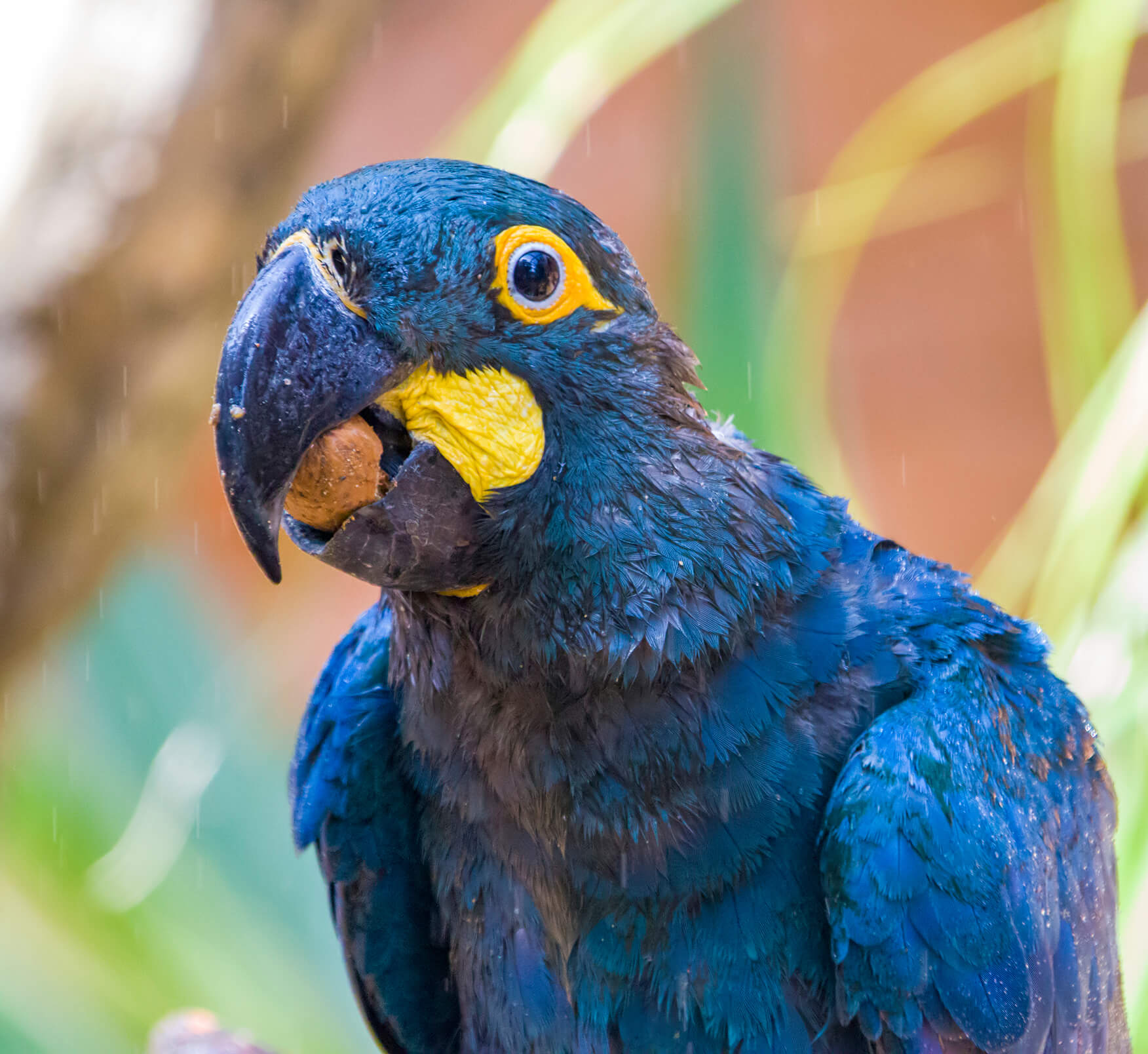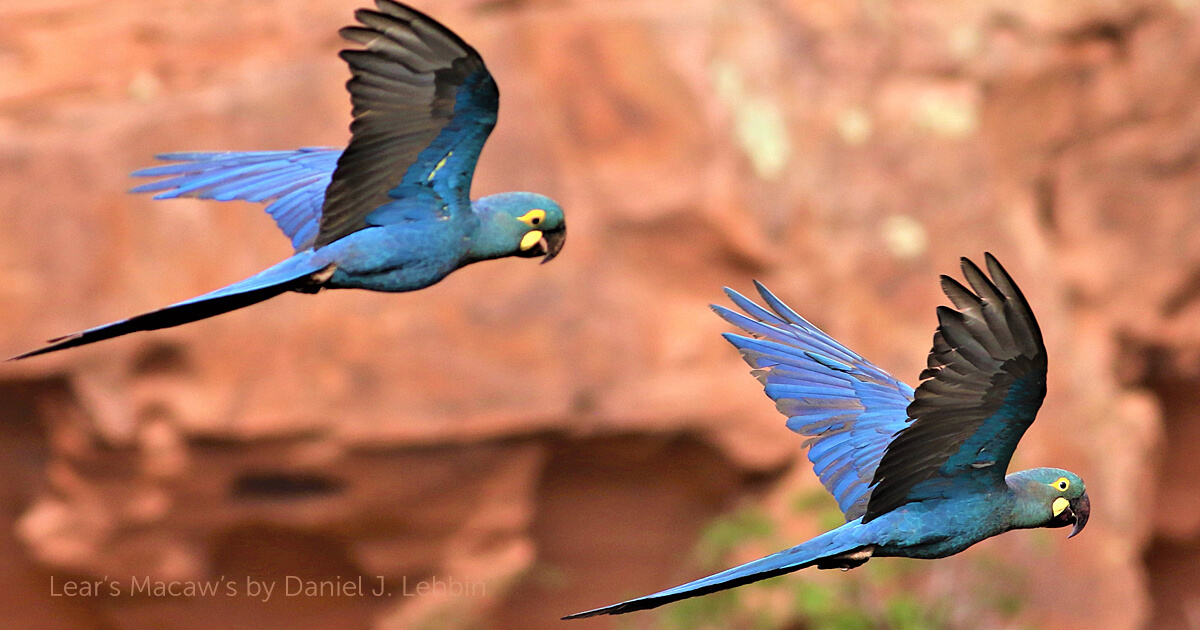
Lear’s Macaw (Anodorhynchus leari), also known as the Indigo Macaw, is a rare and striking species of parrot endemic to northeastern Brazil. Here’s a detailed overview of this beautiful and endangered bird:
🦜 Quick Facts:
- Scientific Name: Anodorhynchus leari
- Common Names: Lear’s Macaw, Indigo Macaw
- Conservation Status: Endangered (IUCN Red List)
- Family: Psittacidae (true parrots)
- Lifespan: Up to 50 years in captivity
- Length: Around 70–75 cm (27.5–30 in)
- Weight: ~950–1,300 grams
🌍 Habitat:
Lear’s Macaws are found only in a very small region of Bahia, Brazil, where they inhabit semi-arid caatinga – a dry shrubland biome. They roost and nest in sandstone cliffs and forage in nearby areas.
🌿 Diet:
They are specialized feeders, with a strong preference for the fruits of the licuri palm (Syagrus coronata), which are rich in fats and crucial to their survival. They may also eat other fruits, seeds, and nuts.
🪹 Breeding:
- Breeding Season: Typically from December to May
- Nesting: In crevices in vertical sandstone cliffs
- Clutch Size: Usually 1–2 eggs
- Parental Care: Both parents help raise the chicks
⚠️ Conservation Status and Threats:
Lear’s Macaw was once believed to be extinct or unknown in the wild until it was rediscovered in 1978. Its population has faced severe threats, including:
- Illegal trapping for the pet trade
- Habitat destruction (particularly loss of licuri palms)
- Persecution by farmers (due to crop raiding)
However, thanks to dedicated conservation efforts, its population has increased to over 1,200 individuals (as of recent estimates). These efforts include:
- Habitat protection and restoration
- Community education
- Captive breeding and reintroduction programs
- Legal protections
🧬 Taxonomy & Relation:
Lear’s Macaw is closely related to the Hyacinth Macaw (Anodorhynchus hyacinthinus) and the now-extinct Glaucous Macaw (Anodorhynchus glaucus), all members of the Anodorhynchus genus.
📸 Fun Fact:
Despite their size and power, Lear’s Macaws are quite social and gentle in temperament, often seen flying in small flocks and engaging in mutual preening.




Here are some beautiful photos of Lear’s Macaw (Anodorhynchus leari) in its natural habitat:
- The vivid blue plumage contrasted against Brazil’s sandstone cliffs 🌄
- Close‑up shots highlighting its distinctive yellow facial patch and black bill
- Birds feeding on licurí palm nuts and flying in small flocks
🦜 About the Species
- Scientific Name: Anodorhynchus leari
- Common Name: Lear’s Macaw or Indigo Macaw en.wikipedia.org+12en.wikipedia.org+12loroparque-fundacion.org+12seaworld.org+2abcbirds.org+2abcbirds.org+2birdsoftheworld.org+1abcbirds.org+1birdsoftheworld.org+3gettyimages.com+3abcbirds.org+3
- Size & Appearance: Typically 70–75 cm long, around 950 g, with metallic indigo-blue plumage, a pale-yellow skin patch near the bill, and yellow eye-rings en.wikipedia.org
🌿 Habitat & Distribution
Lear’s Macaws are endemic to northeastern Bahia, Brazil, in dry caatinga shrublands. They roost and nest exclusively in sandstone cliff cavities within just two known colonies south of the Raso da Catarina plateau abcbirds.org+5animalia.bio+5loroparque-fundacion.org+5. These areas also host licurí palm stands (Syagrus coronata), which are crucial for their diet mindenpictures.com+8abcbirds.org+8loroparque-fundacion.org+8.
🍽️ Diet & Behavior
- Diet: Primarily licurí palm nuts (up to 350 per day), along with other seeds, agave flowers, maize, and occasionally flowers parrots.org+3abcbirds.org+3seaworld.org+3.
- Social Structure: Gregarious birds living in flocks of ~8–30. They roost in clans of 3–4, and breed in monogamous pairs in cliff crevices parrots.org+5animalia.bio+5parrots.org+5.
🛡️ Conservation & Population
- Status: Endangered (IUCN, CITES Appendix I) parrots.org+4seaworld.org+4abcbirds.org+4
- Threats: Habitat loss (especially of licurí palms), trapping, hunting, crop conflict mindenpictures.com+8abcbirds.org+8loroparque-fundacion.org+8.
- Population Recovery: Once as low as ~60 in 1983, now estimated between 1,200–1,700 individuals (though many are juveniles). Conservation programs—including habitat protection, reforestation, farmer compensation, and captive breeding—increased numbers dramatically since the 1990s .
❤️ Why It Matters
Lear’s Macaw is a remarkable conservation success story. Through coordinated efforts by Brazilian authorities, ABC, BirdLife International partners, and Loro Parque Fundación, the species rebounded from near extinction. Beyond numbers, their survival supports co-dependent species and ecosystems, from licurí palm forests to local communities relying on ecotourism.